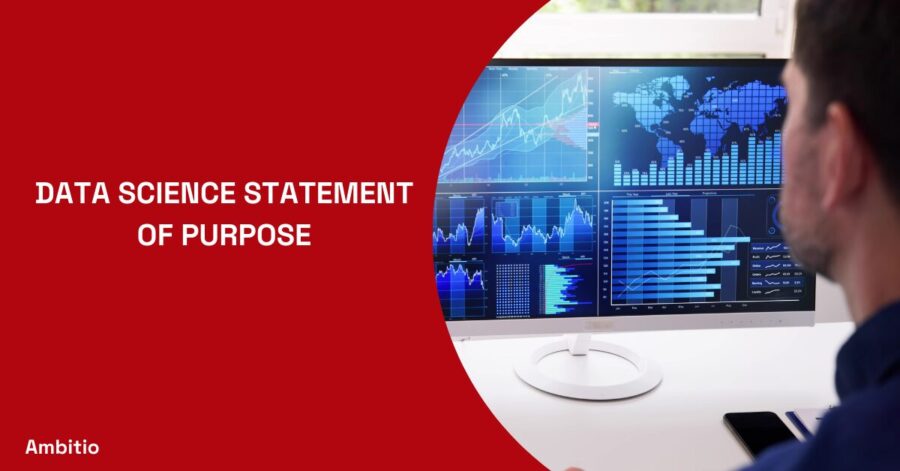13 December 2024
8 minutes read
Crafting the Perfect Data Science Statement of Purpose (SOP)

Embarking on a Master’s in Data Science is a transformative journey, one that opens doors to the vast and ever-evolving world of data analytics. At the heart of this journey lies your Statement of Purpose (SOP) – a narrative that not only recounts your academic and professional experiences but also reflects your aspirations and dedication to the field of data science
In the competitive realm of academia, a well-crafted SOP can set you apart from a sea of applicants. It is your chance to speak directly to the admissions committee, to convince them why you are the ideal candidate for their program, and to showcase the unique perspective you bring to the table. Let’s demystify the process of creating an SOP that resonates with your dream university’s data science program.
The Intricacies of a Data Science Statement of Purpose
A Master’s in Data Science is not just about possessing the technical skills; it’s about demonstrating a keen analytical mind, a penchant for problem-solving, and a vision for how data can shape the future. Your SOP should encapsulate all these elements in a coherent and engaging narrative.
Tailoring Your SOP for the Data Science Landscape
Crafting an SOP for an MS in Data Science requires more than just academic transcripts and professional accolades; it requires a narrative that weaves together your past experiences with your future ambitions.
Integrating Your Past Experiences
Begin by reflecting on your academic journey. Have you taken courses in data structures, algorithms, or statistical methods? Have you worked on any projects or research that involved data analysis or machine learning? These experiences lay the groundwork for your SOP, showcasing your academic readiness for advanced studies in data science.
Outlining Your Future Ambitions
Equally important is your vision for the future. What do you hope to achieve with a Master’s in Data Science? Perhaps you aspire to drive innovation in healthcare through data analytics, or you aim to leverage machine learning to solve environmental challenges. Articulate these goals with clarity and conviction to align your objectives with the program’s offerings.
Emphasizing Work Experience and Research Interests
Your professional background and research interests can significantly bolster your SOP. They demonstrate your practical understanding of data science and your potential to contribute to the field.
Highlighting Relevant Work Experience
Professional experience in data science-related roles can be a testament to your skills. Use this section to discuss significant projects you’ve led or contributed to, problems you’ve solved, and any recognition you’ve received for your work. Detailing these experiences can provide a glimpse into your hands-on expertise and your ability to apply data science principles in real-world scenarios.
Showcasing Your Research Interests
If your path includes research, elaborate on it. What questions drive you? What findings have you unearthed? How does your research complement your academic and professional pursuits? Link your research interests with the faculty’s work at the university to demonstrate how your goals align with their expertise.
The Power of a Personalized SOP
Your SOP should be a mirror reflecting your personality, not just a summary of your CV. This is where your unique story comes to life.
Weaving in Your Personal Story
What motivated you to pursue data science? Share your “aha” moments, the challenges you’ve faced, and how they’ve shaped your decision to continue in this field. A personal story can be a powerful way to connect with the admissions committee, making your application memorable.
Revealing Your Passion for Data Science
Passion is the fuel that drives the engine of innovation. Convey your enthusiasm for data science by discussing what excites you about the field. Is it the ability to predict and influence trends, or the satisfaction of unraveling complex data sets? Let your passion shine through your words.
Articulating Your Professional Goals in Data Science
Understanding where a Master’s in Data Science can take you professionally is crucial for a focused SOP.
Short-Term Professional Aspirations
Begin by outlining your immediate professional goals post-graduation. Whether it’s joining a tech giant as a data scientist, starting your venture in the field of data analytics, or contributing to research and development, clarity on your short-term goals demonstrates purpose and direction.
Long-Term Career Vision
Your long-term career aspirations reflect your ambition and commitment to the field. Discuss how a Master’s degree is integral to achieving these goals. Whether you see yourself as a future CTO, a thought leader in data policy, or an entrepreneur, your SOP should bridge your current state to your ultimate professional destination.
Addressing the Program Specifics in Your Data Science SOP
When it comes to writing a Statement of Purpose for a Master’s in Data Science, the devil is in the details. Tailoring your SOP to the specific program you are applying to demonstrates not only your attention to detail but also your genuine interest in what the program has to offer. Let’s delve into how you can effectively address program specifics to make your SOP stand out.
Why This Program?
To convincingly articulate why a particular program is the right fit for you, you must first thoroughly research the program’s curriculum, faculty, research opportunities, and culture.
Start with the curriculum: identify courses that are unique to the program and explain how they align with your academic interests and professional goals. Discuss the program’s approach to data science — whether it’s more theoretical, practical, or a blend of both — and articulate why this approach resonates with you.
Next, consider the faculty members and their research interests. Are there professors whose work inspires you or aligns with your own research aspirations? Mentioning specific faculty members and their research can show the admissions committee that you are proactive about your education and eager to engage with their work.
Another aspect to highlight is the program’s resources and facilities. Does the program offer any unique labs, equipment, or collaborative opportunities with the industry? Mention how access to these resources will be instrumental in your studies and future career.
How Do You Fit In?
Once you’ve covered why the program is ideal for you, flip the perspective: illustrate how you would be a valuable addition to the program. Reflect on your academic achievements, projects, or work experiences that make you a suitable candidate.
Perhaps you have experience with a particular programming language or software that is widely used within the program, or maybe you have tackled research problems similar to those being explored by the program’s faculty.
Discuss your collaborative experiences and how they have prepared you to work within the program’s team-based projects or research groups. If the program prides itself on a diverse and inclusive community, share your experiences working with diverse teams and your understanding of the importance of varied perspectives in data science.
Personalizing Your Intent
Admissions committees read thousands of SOPs. To ensure yours is memorable, inject personality into your writing. Beyond stating facts, tell stories that highlight your curiosity, your problem-solving abilities, and your dedication to the field of data science.
Share an anecdote about how you overcame a significant challenge in a project or how a particular class ignited a passion for a specific area within data science.
Your SOP should not only reflect your academic and professional compatibility with the program but also your personal alignment with the program’s values and culture. If the program emphasizes entrepreneurship, for instance, discuss your ambition to start a data-driven business or how you hope to use data science to drive social change.
Aligning with the Program’s Vision
Every program has a vision or a set of goals they aim to achieve through their graduates. This vision could be training the next generation of data science leaders, advancing the field through innovative research, or applying data science to societal problems. Show that you share this vision and are committed to contributing to it.
If the program is known for a specific specialization or industry connection, discuss how this aligns with your career trajectory. For example, if the program has a strong focus on artificial intelligence and this is an area you wish to specialize in, make this connection clear. If the program boasts strong placement rates in certain sectors where you aspire to work, discuss how this motivates your choice.
SOP Writing: Final Considerations and Proofreading
Crafting a Statement of Purpose (SOP) is akin to creating a self-portrait with words. It’s about painting a picture for the admissions committee that is as vivid and compelling as it is accurate and truthful.
As you approach the final stages of SOP writing, there are several key considerations to ensure your document not only stands out but also reflects your best self.
Ensuring Cohesion and Flow
A well-written SOP must have a natural flow, guiding the reader through your past experiences, present competencies, and future aspirations. It should tell a coherent story, where each paragraph smoothly transitions to the next, and every sentence supports your central theme: why you are a perfect fit for the MS in Data Science program.
To achieve this cohesion, start by creating an outline before you write. Organize your content with logical headers and subheaders. Each section should build upon the previous one, creating a narrative arc that culminates in a strong conclusion. Your introduction should grab attention, your body should hold interest, and your conclusion should resonate.
The Importance of Proofreading
Proofreading is a crucial step in the SOP writing process. It is not merely about correcting typos or grammar mistakes; it’s about refining your tone, ensuring clarity of expression, and maintaining a professional demeanor throughout the document. Here are some proofreading tips to consider:
- Take a Break: After you’ve completed your SOP, step away from it for a day or two. Approaching the document with fresh eyes can help you spot errors and areas for improvement.
- Read Aloud: Reading your SOP out loud will help you catch awkward phrasings and run-on sentences. If you stumble over words, it’s likely that your reader will too.
- Peer Review: Have someone else read your SOP. Choose individuals who can offer constructive criticism, whether it’s a mentor, a colleague, or a friend.
- Professional Services: If possible, consider using professional proofreading services. Professionals can offer insights that you may have overlooked and can help polish your SOP to a high sheen.
- Check for Consistency: Ensure that you are consistent in your use of tense, tone, and style. An SOP that switches from formal to casual or past to present tense can be jarring and give an impression of carelessness.
- Attention to Detail: Look out for common mistakes such as the misuse of homophones (e.g., ‘there’, ‘their’, ‘they’re’) and subject-verb agreement. Such errors can undermine the credibility of your SOP.
Addressing the University and Program Specifically
Personalization is key in making your SOP stand out. Mentioning the university and specific aspects of the program shows that you are not sending a generic statement to multiple schools.
Tailor your SOP to reflect a deep understanding of what the university and the program offer and how they align with your goals. If there are certain professors under whose guidance you wish to study, or specific courses you are excited about, mention them. Demonstrating this level of detail illustrates your commitment and genuine interest in the program.
The Final Read-Through
During your final read-through, pay attention to the narrative as a whole. Does your SOP clearly articulate your journey and your enthusiasm for data science? Does it end on a strong note, leaving no doubt in the reader’s mind about your qualifications and fit for the program? Is it a true representation of who you are?
This final stage is not just about dotting the i’s and crossing the t’s; it’s about ensuring that your SOP is the definitive narrative of your academic and professional journey, your dedication to data science, and your aspirations for the future. Remember, this document is potentially your one opportunity to speak directly to the admissions committee. Make it count.
Conclusion: The Data Science SOP as Your Personal Advocate
Your data science statement of purpose is not merely a document; it is a crafted piece of personal advocacy. It encapsulates your academic prowess, professional experiences, and the uniqueness that you will bring to the master’s program.
With thoughtful consideration and strategic composition, your SOP can serve as a compelling testament to your potential and readiness to transform the world of data science.
Remember, every word you write is a step closer to the future you envision in the vast and dynamic field of data science. Make it count.
FAQs for SOP Writing in Data Science
Q1: How long should my data science SOP be?
Generally, SOPs are between 500-1000 words, but always check the program’s req
Q2: Can I include projects in my SOP
Absolutely! Discussing relevant projects can showcase practical skills and knowledge in data science.
Q3: Should I mention specific faculty or research happening at the university?
Q3: Should I mention specific faculty or research happening at the university? A: Yes, this shows that you have done your research and are keen on being a part of specific research initiatives.
Q4: How do I start my SOP?
Begin with a compelling hook – a personal story, a poignant question, or a bold statement related to your interest in data science.
Q5: Is it necessary to have my SOP professionally edited?
While not necessary, professional editing can enhance the clarity and impact of your SOP.

You can study at top universities worldwide!
Get expert tips and tricks to get into top universities with a free expert session.
Book Your Free 30-Minute Session Now! Book a call now




























